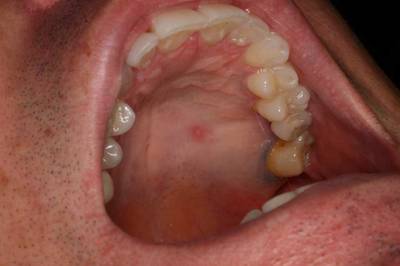Rough Patch On Roof Of Mouth
Sore Throat (Pharyngitis) on May 30, 2017 • Health Guide • • • What Is It? A sore throat, also called a throat infection or pharyngitis, is a painful inflammation of the back part of the throat (pharynx). Pharyngitis can involve some or all of these parts of the throat: • the back third of the tongue • the soft palate (roof of the mouth) • the tonsils (fleshy tissue that are part of the throat's immune defenses). The most common cause of sore throat is infection with bacteria or a virus. Because an infection of the pharynx almost always involves the tonsils, tonsillitis (inflammation of the tonsils) was once a common name for infectious pharyngitis.
Mouth White Patches Information Including Symptoms, Diagnosis, Treatment, Causes, Videos, Forums, and local community support. Find answers to health issues you can trust from Healthgrades.com.
About 90 percent of throat infections are caused by a virus. Although people who have the flu (influenza), cold sores (oral herpes simplex) or infectious mononucleosis ('mono') also commonly have a sore throat, these viral infections usually cause other telltale symptoms in addition to throat pain. In regions that have warm summers and cool winters, viral pharyngitis typically peaks during the winter and early spring. This is a time when people are more likely to gather in poorly ventilated rooms. The viruses that cause pharyngitis spread easily.
The viruses can spread through the air by hanging on to droplets from coughs and sneezes. They stick to unwashed hands that have been exposed to fluids from a sick person's nose or mouth. In most people who are otherwise healthy, simple viral pharyngitis doesn't last long, goes away on its own and does not causes any long-term complications, although the short-term discomfort can be significant. In cases of infectious pharyngitis that are not viral, the cause is almost always a bacterium — usually a group A beta-hemolytic Streptococcus, which causes what is commonly called strep throat. Like viral pharyngitis, strep throat can spread quickly and easily within a community, especially during late winter and early spring. Unlike most forms of viral pharyngitis, however, untreated strep throat can lead to serious complications, such as glomerulonephritis (a kidney disorder) and rheumatic fever (a potentially serious illness that can damage heart valves). A strep infection also has the potential to spread within the body, causing pockets of pus (abscesses) in the tonsils and in the soft tissue around the throat. Elements of discrete mathematics c.l. liu pdf.
Symptoms The main symptom of pharyngitis is a sore throat and pain with swallowing. In infectious pharyngitis, other symptoms vary depending on whether the infection is viral or bacterial (usually strep throat): • Viral pharyngitis — Sore throat often is accompanied by other symptoms, such as: • A red throat • Runny or stuffy nose • Dry cough • Hoarseness • Redness of the eyes Children may have diarrhea.

Small Rough Patch On Roof Of Mouth
Some viruses cause painful sores in and around the mouth, including the lips. • Strep throat — Strep throat and other forms of bacterial pharyngitis cause sore throat, pain with swallowing and a red throat. These symptoms tend to be more severe with Strep throat compared to viral pharyngitis. Other symptoms that often occur with Strep throat include:, • Fever • Body ache and a general sick feeling generally sick feeling • Headache • Enlarged tonsils with a white spots • Swollen, tender lymph nodes (swollen glands) in the front of the neck. Children also can have nausea, vomiting and abdominal pain. Because symptoms of viral and bacterial pharyngitis can overlap, it may be difficult for the doctor to distinguish between them based on symptoms alone. As a general rule, if you have a prominent cough and nasal symptoms you are more likely to have viral pharyngitis than strep throat.